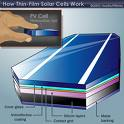 MAKERS of solar cells face a dilemma. Purified silicon, the basic material of such cells, is expensive. The temptation, therefore, is to use less of it. As a result, the makers have developed a generation of cells whose silicon layers are only a micron or two deep, as opposed to the usual thickness of 200-300 microns. The thinner the cell, however, the less efficient it is. In particular, thin cells fail to capture much light at the red end of the spectrum. That means they produce up to 20% less electricity than standard cells of equivalent area. And that negates some of the advantage of their initial cheapness.
MAKERS of solar cells face a dilemma. Purified silicon, the basic material of such cells, is expensive. The temptation, therefore, is to use less of it. As a result, the makers have developed a generation of cells whose silicon layers are only a micron or two deep, as opposed to the usual thickness of 200-300 microns. The thinner the cell, however, the less efficient it is. In particular, thin cells fail to capture much light at the red end of the spectrum. That means they produce up to 20% less electricity than standard cells of equivalent area. And that negates some of the advantage of their initial cheapness.
MAKERS of solar cells face a dilemma. Purified silicon, the basic material of such cells, is expensive. The temptation, therefore, is to use less of it. As a result, the makers have developed a generation of cells whose silicon layers are only a micron or two deep, as opposed to the usual thickness of 200-300 microns. The thinner the cell, however, the less efficient it is. In particular, thin cells fail to capture much light at the red end of the spectrum. That means they produce up to 20% less electricity than standard cells of equivalent area. And that negates some of the advantage of their initial cheapness.
To remedy this problem, Kylie Catchpole of the Australian National University in Canberra and Albert Polman of the Institute for Atomic and Molecular Physics in Amsterdam have been trying to redirect the light that falls onto the surface of a cell in such a way that all colours are efficiently absorbed. Their chosen tools for this task are tiny particles of silver.
When struck by light, the electrons in an atom of silver vibrate in a way that causes them to radiate small amounts of light themselves. If the atom in question is in a small particle on the surface of a piece of silicon, the result is what is known as a surface plasmon. This is a type of electromagnetic wave (ie, the same type of wave as a light wave). However, as its name suggests, it runs parallel to the surface of the material that is propagating it, rather than penetrating this material.
By travelling horizontally in this way, a plasmon passes through more of the solar cell’s silicon than any incident beam from the sun could. In effect, the cell has been turned on its side and made much thicker. That gives it the opportunity to absorb, and thus convert into electricity, most of the red light falling on it, as well as the blue. Indeed, Dr Catchpole and Dr Polman report in Optics Express that their system increases the absorption of red light tenfold—bringing the efficiency of thin cells much closer to that of the traditional sort.
Of course, silver is expensive. But so little is used that the new technique would add only a few cents to the price of a solar panel. And it would bring the day closer when solar electricity is as cheap as that generated from coal.

 Previous page
Previous page Back to top
Back to top







